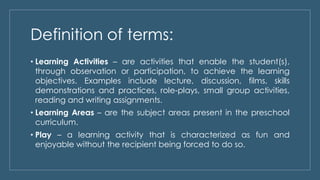This document provides an overview of creative learning activities for young children. It defines key terms like learning activities and learning areas. It discusses various preschool curriculums and the learning areas/standards in preschool, including language, science, mathematics, physical education, and more. It also addresses developmentally appropriate activities in preschool like various types of play. Finally, it discusses selecting developmentally appropriate materials for young children and reflects on designing preschool activities and environments that suit children's needs.
















































































